
Contact

Home


The "Marble Man" in Bathurst
Bathurst Free Press and Mining Journal (NSW)
Date: May 23, 1890
Page Number: 3
In our issue of yesterday we published an extract from the News concerning a visit which "The Tourist" had made to the Caleula Marble quarry ; but before the paper was in the hands of our readers we had an opportunity of inspecting the "marble man" therein described. The ponderous curiosity had been brought to Bathurst by Mr. Sala and his boy, and having received an invitation to inspect, we proceeded at once to one of Mr. Willis' shop in Keppel-street, where the figure was being unpacked. As the peculiar mass was turned out of the case in which it had been carried (it is said to weigh 5oolbs.) the three or four visitors in the room felt a sort of awe creep over them, for the features of a man could be plainly distinguished ; and when it was placed in position the hands and feet, or what were supposed to be such, could also be distinguished. The description given by "The Tourist " is fairly correct. The head is 36in round. The neck 35in ; 22in across the chest to each shoulder; from the crown of the head to the, chin 17in ; while the whole figure is only 3ft 6in in length. The width across the forehead is about 14 inches, and from the base of the skull to the tip of the nose the measurement is 13½ inches. The nose is large and broad, like an aboriginal's, the lips thick, and the eyes large, but the ears are remarkably small. The figure is in a crouching position, the legs and arms bent just in the attitude a man would assume in sitting upon his heels. The figure is evidently marble, but has apparently been coated over with some chalky substance. Mr. Sala declares that the man ''was sitting on a horse or some other animal when discovered, and that this had been destroyed by the blasting necessary to extract it from the quarry. Other pieces of marble are shewn, one having the appearance of a baby's foot, another a camel's hoof, and a third a man's hand ; and Mr. Sala states that there is a huge whale or elephant to be seen at the quarry. We offer no opinion on this marvellous subject. It may be a man in petrifaction or may not ; but it certainly forms a very interesting exhibit. One of the visitors suggested that as there was a whale in his company he may have formed one of Pharoah's host, which was swallowed up in the Red Sea : but the others could not swallow this at all. The public will no doubt have an opportunity of inspecting the novelty, as we believe it is Mr. Sala's intention to give a public exhibition.
Bathurst Free Press and Mining Journal (NSW)
Date: May 23, 1890
Page Number: 3
The 'marble man' has the head of a giant, but the feet of a dwarf. The understanding must have been weak in the days when he lived. When the last marble man was exhibited there was a good deal of talk about chiselling. But Mr. Sala declares that no chisel wrought the form now shown. Pity he did not leave the figure in the quarry and get some scientific men of note to inspect it there. These things look to much better advantage in situ.
And then, you know, people could not say nasty things about manufacture.
The Marble Man and Horse.
Bathurst Free Press and Mining Journal (NSW)
Date: June 10, 1890
Page Number: 2
What is said to be a marble horse is now on viewat the Royal Hotel. It was taken from the quarry at Caleula, from which the "marble man" was excavated, and Mr. Sala says the man was originally sitting upon this "horse." The trunk (if it be a trunk) only is on view, as the head (if it was a head) is said to have been smashed in the blasting operations. The exhibits are certainly curiosities.
The Sydney Morning Herald (NSW)
Date: March 19, 1891
Page Number: 7
A petrified man has turned up at Los Angelos in the United States, and led as a matter of course to as much controversy as the petrified man exhibited in Sydney a faw years ago. It is declared by the press to be a gross imposture, and only one of many, and declared to be the work of a "vagabond artist," The Evening Express (a journal published in Los Angolos) of the 15th February, prints a lengthy article, the result of a research into the authenticity of the recently discovered petrified man. It declares the alleged petrification is a fraud, and the work of the same Italian sculptor who made the Cardiff giant, the Colorado stone man who had a rudimentary tail and was thought to be some missing link, and who also fabricated the gigantic nude figure near the Giant's Causeway in Ireland, and said to have been Finn M'Cool, an Irish giant and king, of the fourth century, and now on exhibit in the British Museum as an antiquarian relic. The Empress says the figure was sculptured from sandstone, then treated with acid both to impart a water-worn and antiquated appearance, and taken to a lonely canyon in Fresno county and buried, where it was subsequently unearthed.
THE COLORADO "STONE MAN" IN NEW YORK.
Launceston Examiner (Tas.)
Date:May 10, 1878
Page Number: 3
(From the New York Tribune.)
A so-called "petritied man," from Colorado, whose journey through the country has been accompanied by the Western press with much rhetoric, is on exhibition at the Aquarium. It is the stone figure of a man in a supine position, seven and a half feet high. The weight is said to be about 600lb. The right arm is thrown over the chest, one leg is somewhat drawn up, and as the body lies slightly inlined on one side, a short tail is perceptible to the careful observer. The features are of a Indian type and yet regular, although the cheek bones are high, and the forehead low and receding. The posterior cranium, however, is enormous. Muscular development is small for so large a figure. The outer surface of the body looks corroded. William A. Conant, of Colorado, who for the past two years has been the business agent at Colorado Springs for the Atchison, Topeka and Santa Fe railroad, claims that for several years past he has been searching for geological specimens in various parts of the State, and that on 10th September, while so engaged, his attention was attracted by a curiously formed stone protruding from the ground. He began digging, and exhumed what he now claims to be the petrified form of a human being. At the Aquarium last week opinion varied. Some things were noticed that raised doubts as to the body being a petrefaction. For instance, as petrefaction is not of course instantaneous, the softer portions of the body the abdomen for example, while putrefaction was in progress, would cave in. But the body showed no defect in that respect. A Tribune reporter measured, with a tape measure, the left and right fore-arms, and discovered that the former was seventeen and a half inches long, and the latter six teen and a quarter inches long. Dr. Geo. K. Smitlh, of Brooklyn, and Dr. Erskine Mason, demonstrator of anatomy to the College of Physicians and Surgeons, measured the fore-arm with the same-result. Another doctor tried it, and not taking the measure in exactly the right direction, made the difference an inch and a half. Mr Conant was not far away, talking about his prodigy. He was told that a difference of an inch and a half existed in the two fore-arms. "Impossible, impossible, gentlemen," he said. "The fore-arms are perfect in size and of the same length. This thing has been measured too often to have any difference discovered." Then he became excited. "Gentlemen, I will give 1000dol to any charitable institution in New York you may name if there is found a difference of an inch and a half in the fore-arms." "Measure it yourself," was the reply. He found that the left forearm was an inch and a quarter longer than the right by his own measurement. "A thousand dol" was the general cry, but Mr Conant said that an inch and a half difference had not been proved. "There is no evidence that the difference results from dislocation or decayed bones," said Dr Smith. A measurement was then made of the entire arms ; they were of the same length. "The sculptor measured from shoulder to finger tip," said one physician, "but forgot to messure the forearm." Dr. Wm. A. Hammond was present, and laughed at the discovery which had been made. "The cleanest way," he said, "to show, up the petrefaction is to cut a vertical section, and then the bone cells, if there ever were any, will be visible.". The reporter proposed to Mr Conant to bring up two of the most prominent physicians in the city in order to test the matter by examining a vertical section. Mr Conant, however, said he wouldn't have the body out, not even a toe, except by a man of national reputation who would settle the matter once for all. The reporter proposed the names of several men of national reputation, but Mr Conant would not consent. Mr Conant displayed some crystals during the afternoon which he said were taken from the body, in the neck, where a hole had once been bored. It was now closed. The reporter took two pieces to Professor J. S. Newberry, of the Columbia College School of Mines. "They are crystals of calcite," said the Professor. "I have been studying some accurate photographs of the 'petrefaction' which have been sent me, and although I haven't seen it think it is a fraud for several reasons. The flesh of no animal has ever been preserved, but this potrefaction is a figure with' all the integuments, eyelids, lips, and nostrils complete. I look upon the whole thing as a Cardiff giant affair. The theatrical portion, the finding, has been well worked up, but the incongruities of the manufacture are too striking. Those crystals could only be present in the body where the substance had disappeared, and the vacancy had been filled by the deposition of lime by solution."
The Colorado stone man proves to be a veritable brother of the [Cardiff] giant, having been begotten by the self-same father. Hull cleared some 160,000 by the latter, with which he embarked in business in Binghamton, New York, by which every dollar was lost. Of late he has been given to the pursuit of experimental chemistry, and, taught by the popular views of Darwin, as expounded by the public press, he be- gan planning to again astonish the good people of the United States. This seemed to take great hold upon his mind, and he frequently remarked that he would like to set the scientific men quarreling as to the origin of man, and throw the religious world into a vortex of doubt and controversy.
Popular Science Monthly, June 1878.
RELICS OF A PREHISTORIC RACE.
Mornington Standard (Vic.)
Date: October 8, 1891
Page Number: 3
News comes from the Sequatchie Valley of the discovery of a petrified man, surrounded by bronze instruments and not far from a tablet containing 467 words written in character resembling Hebrew. The story has somewhat the sound of a fake, but the use of Professor N. S. Shaler's name, which would be unpardonable in this connection if he was not there, gives a color of probability to the story. If it is a fake, it is wonderfully well written and more consistent in its details than such thing usually appear. The mention of characters resembling the Hebrew sets in motion an interesting train of speculation. The theory was long ago advanced that the North American Indians were of Semitic descent, and various arguments, based on the philology of the Indian and Hebrew races, have been made to support this view. Some have gone so far as to assert that the Indians were the lost tribes of Israel, come to America from Asia by way of Alaska. The successive migrations of Toltecs and Aztecs from the north-west to Mexico have afforded another scintilla of the evidence out of which the fabric of the theory has been constructed. All this has been interesting, but appeared more or less mythical until the unexpected outcropping of certain Indian folklore, "which sheds new light on the matter.. One of the wildest Indian tribes on the Western border was reduced to subjection by the United States army when those savages were still unable to speak even broken English. They could only make themselves understood by signs, and it was found by subsequent inquiry that no priest or missionary had ever visited them. These people had a tradition of the deluge and the destruction of all but one family, who escaped in a big boat. Finally, when the waters began to subside, they sent out, not a dove, but a coyote. This story is vouched for by Benteen, a retired officer of the United States cavalry, who held these Indians as prisoners of war, and heard the tradition from them, after he had heard enough of their language to communicate with their chief. Now if the story of the find in the Sequatchie Valley is true, and it turns out that the alleged alphabet has anything in common with the Hebrew, the evidence will be as conclusive as circumstantial evidence could be that the early in habitants of this continent were of Semitic origin. It seems strange, however, that there should have been on this continent a race which was far enough advanced in civilisation to use an alphabet and yet not strong enough to impress its ideas and its progress upon its successors. That is the hardest thing to believe.--"Alanta Constitution."
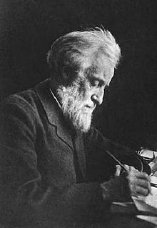
Nathaniel Shaler
American paleontologist and geologist.

CONVERSAZIONE AT THE GREAT HALL OF THE UNIVERSITY.
The Sydney Morning Herald (NSW)
Date: October 1, 1892
Page Number: 7
...
The exhibits in the Great Hall included the "marble" man, respecting which the programme informed visitors that "This curious specimen is alleged to have been found near Orange, N.S.W. If it be genuine, its has been alleged, then it takes the antiquity of man back to the Silurian period, when until this discovery of the "marble" man -- the highest known forms of animal life were scorpions and fish, so that man would have appeared on the earth ages before even birds, not to speak of monkeys and all the lower mamals."
...
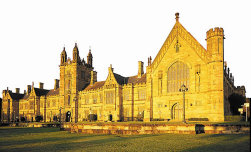
Great Hall, University of Sydney
Illustrated Sydney News (NSW)
Date: October 8, 1892
Page Number: 15
The "marble man" came in for his share of attention, and no wonder, for his career has been very human after all. First the object of curiosity, then of fame then accused of fraud and covered with shame and contempt, overwhelmed with pecuniary difficulties and even imprisoned for fraudulent insolvency,and finally "white washed" and quitely put on the shelf.
Illustrated Sydney News (NSW)
Date: November 19, 1892
Page Number: 5
They say the Marble, Man is going to Chicago. Extra special representative of New South Wales, probably. We hope the Yankees, won't take him for the ghost of Sir George's naughty, naughty word.
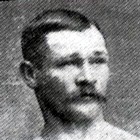
Jim Burge
Australian Lightweight Boxer
Sydney, New South Wales
aka: Jim Burgess, the "Marble Man"
Record (1887-1895): won 10 (KO 8) + lost 8 (KO 4) + drawn 11 = 34
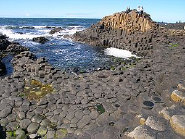
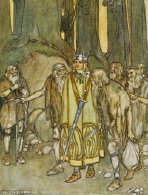
Left:
Giant's
Causeway


Right:
Fionn mac Cumhaill
(Finn McCool)
TYPHRID FAVER.
Northern Star (Lismore, NSW)
Date: March 25, 1893
Page Number: 2
SIR,--It was late on the week when I read that most amusing letter which appeared in your contemporary headed "Typhrid Favor," signed "Faugh-a-ballagh," and it was with some difficulty I got through it, as my face was simply bathed in tears, caused--as you will readily imagine--by irrepressible bursts of laughter at almost every line. I'm sure it will not show any preposterous ignorance to confess that the strain of humour so excellently maintained, and the true and charming manner it depicts the Irishman in his pronunciation of the English language, places it at least in the forefront of anything in the history of local humourous productions. Howover, when I did got through it and recovered myself, it struck me that, as most of us have heard a good deal about the "hairy man" and the "marble man," and other sorts of man, to these celebrities Lismore should now have the credit of having produced the "funny man" in "Faugh-a-ballagh." His mimicking the Irishman (with the acshent all over the Irishman, moind) is inimitable, and it is to be regretted that such latent talent should remain undeveloped. Mark Twain, Max O'Rell, Flaneur and others will look with a jealous eye to the career of "Faugh-a-ballagh," whose genius will excel them all, should he be persuaded to enter the ranks of their profession, which his humorous production in reply to "Leo" shows he was assuredly born to follow. It is to be hoped the generous people of Lismore will not leave neglected the training of this phenomenally gifted humourist. Should such a misfortune occur our "funny man" and your readers will have one more striking illustration of the truth of the poet's words:
" Full many a flower is born to blush unseen."
Yours, &c.,
Lismore, 24/3/'93. Toby.
The Mercury (Hobart, Tas.)
Date: April 28, 1893
Page Number: 4
...
Another song, sung to the air of "The Bogie Man," was one having reference to the Challis stutue. It caused many smiles, and a good deal of applause. This is one of the verses--
"Let others praise with high-flown phrase,
The charlm of Kate and Alice ;
We greet one name with loud acclaim,
And cheer our best for Challis.
Soon now you'll scan our mabble man
(Though not MacCarthy's mystery).
And one we struck with great good luck,
The Challis Prof. of History.
Chorus--
"Oh whist! Whist! Whist!
Hero comes the marble man ;
Get in your graft, you grafters,
You , George, and Dan.
Oh whist! Whist! Whist.
He'll pluck you if he can,
And all the cunning, knowing push.
Avoid the hist'ry man."
...
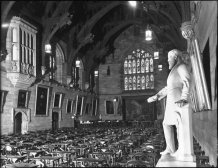
Statue of John Henry Challis in the Great Hall, University of Sydney

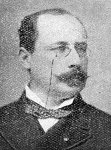
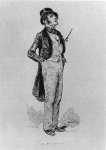
Mark Twain
Max O'Rell
Flâneur
But who was "Faugh-a-ballagh"?
The Mercury (Hobart, Tas.)
Date: May 5, 1893
Page Number: 2
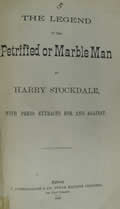

The World's Columbian Exposition (the official shortened name for the World's Fair: Columbian Exposition, also known as The Chicago World's Fair) was a World's Fair held in Chicago in 1893 to celebrate the 400th anniversary of Christopher Columbus's arrival in the New World in 1492.

W. F. Buchanan, one of the owners of the Marble Man, was also part of the Chicago Exhibition Commission which decided how the Australian colonies would be represented.
The Marble Man part 13


















